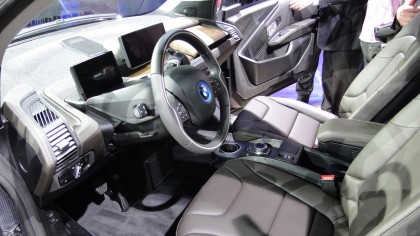Why BMW's revolutionary carbon-fibre i3 is the future of motoring
Carbon-bodied BMW i3 is just part of a "complete mobility" package
So what will the i3 actually be like to live with? How long will it take to charge? Over to Manuel Sattig, Project Manager for BMW i.
"Charging the BMW i3 is more simple than most people think. You can charge on almost any socket. You can charge on the same socket you use to charge your mobile phone. Of course, this takes about 7.5 hours for a full charge," explains Sattig.
Fancy a top up?
That's not a problem for overnight charging, but what if you need a quick top up?
"If you choose the BMW i Wallbox, we send someone to your home and find out what your power supply can handle," says Sattig. The result is a fast-charging solution that cuts the charge time to around three hours.
But what if you don't have a garage? That's the problem for electric cars. They're designed for use in cities where most cars are kept on the street, not in private garages where charging rigs can be installed.

"It's a process. Building the infrastructure takes time. But 90 per cent of a car's life is spent parked. We need to use that time intelligently. At the office, the train station the airport, at the movies, shopping centres," Sattig says.
Charge when you can, then. But BMW can help you here, firstly with the ChargeNow card which aims to unify all the different service operators who offer charging points. In theory, the ChargeNow card will get you access to the lot.
Get daily insight, inspiration and deals in your inbox
Sign up for breaking news, reviews, opinion, top tech deals, and more.
First impressions
What we can say for now is that the car looks great in the, er, carbon fibre. The pillarless opening between the doors really emphasises that this is not a conventional car. As does the exposed carbon weave on the sills.

Up front, what's striking is the clean simplicity of the design. There are no dials and gauges. Just a pair of screens, one in front of the driver and one up front and centre. The materials are mostly very high quality, but there are one or two details that will at least intrigue.
BMW has used an ultra light weight material for part of the door cards. It's in keeping with the remit, but it's not terribly tactile. It looks, well, a bit recycled.

Still, there's plenty of space up front. In the back, things are much more cramped. The illusion of space created by the missing B-pillar disappears when the doors are closed. The appeal of this first i3 as a family work horse is limited.
Sordid matter of money
All of which just leaves us to discuss the sordid matter of money. In the UK, the i3 kicks off at £25,680 including the £5,000 electric vehicle grant provided by the government. If you want the range-extend versions, that'll be £28,830. You can have the BMW i Wallbox fitted for £315.

In reality, we think few people will buy i3's outright. Instead, leasing will be the most popular way to get into an i3. BMW is offering a £369-month deal over 36 months with a £2,995 deposit.
Warranty-wise, you get three-year unlimited mileage general cover and eight years or 100,000 miles cover for the battery.
Technology and cars. Increasingly the twain shall meet. Which is handy, because Jeremy (Twitter) is addicted to both. Long-time tech journalist, former editor of iCar magazine and incumbent car guru for T3 magazine, Jeremy reckons in-car technology is about to go thermonuclear. No, not exploding cars. That would be silly. And dangerous. But rather an explosive period of unprecedented innovation. Enjoy the ride.